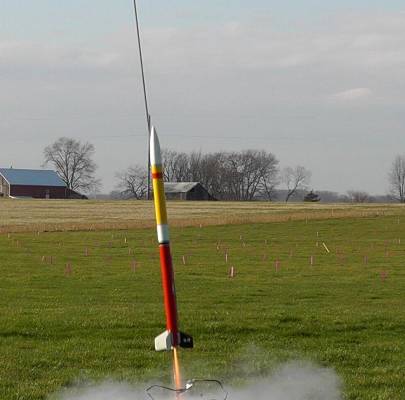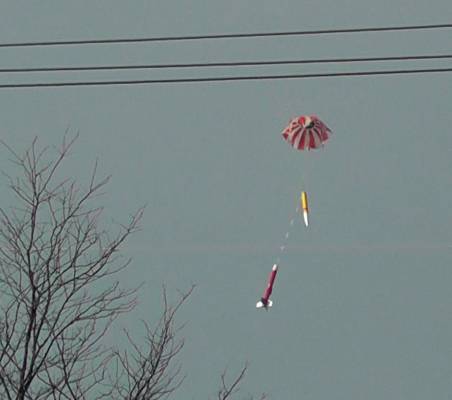The Aero-Hi: This is a cute little flier from Estes using 13mm T engines. It is a pseudo-scale sounding rocket design. This normally uses a tiny 8-inch parachute but was converted to a streamer for a bit, then later converted back into a parachute recovery which I find easier to pack. I actually have two of these, one painted green and this one red. One unique feature of this kit is the simulated conduit up the side of the body tube, made from a balsa strip.
This rocket was later given my "Iris" modification, which extends the body tube about 5 inches above the streamer/parachute bay, and allows for a payload with an Altimeter One or Two to measure altitudes. It's a shame I "ruined" it by adding the payload, she was a cute little bird. (I can always remove the payload.) I like to send this, or the EAC Viper rocket up first on launch days, it's a good and economical way to get an idea how the winds are blowing without risking a lost rocket. As a result, this has flown many times. (Iris is named after the Greek god of the rainbow. She is a messenger of the gods, linking the gods with humanity.) This rocket has flown as high as 282 feet with the A motor, which is higher than the Cape Hatteras Lighthouse in NC, the tallest lighthouse in the USA.
| Flight Date: | 2012-11-23 |
| Rocket Name: | Aero-Hi |
| Kit Name: | Estes - Aero-Hi {Kit} (817) [1973-1974] |
| Flyer's Name: | Rich DeAngelis |
| Motors: | A10-3 |
| Expected Altitude: | 260 Feet |
| Wind Speed: | 9.00 mph |
| Launch Site: | Penn Manor School Lancaster PA |
| Actual Altitude: | 244 Feet |
The second flight of this test used the A10, which I expected to fly faster but not quite as high.
The motor lit and she tore off the pad, pegging the G meter at 23 Gs. The burn averaged 3.3 Gs for the 9/10 second of thrust. The launch was so straight up that I was a bit surprised in the strong winds. The rocket reached a max speed of 68 mph, which was slower than the A3 motor.
After 3.1 seconds while at 233 feet the ejection fired just 1/10 second early, slowing the rocket to reach an apogee of 244 feet. Oddly, this was higher than the A3 flight. It then descended with a good parachute at 7 mph. Flight time was 23.6 seconds. There was a very long walk to recover the rocket, about 450 feet downwind.
| Stage | Motor(s) |
|---|---|
| 1 | Estes A10T-3 |
 |
 |




